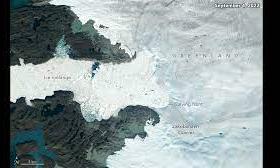
NASA study reveals significant Greenland glacier ice loss
text_fieldsNASA has disclosed that Greenland's glaciers experienced a more substantial loss of ice than previously estimated, posing potential long-term consequences for ocean water levels.
According to a new paper from researchers at NASA's Jet Propulsion Laboratory in South California, Greenland's ice sheet lost approximately one-fifth more ice mass in the last four decades than initially calculated.
The study, published in the journal Nature on Wednesday, sheds light on the escalating rate at which icebergs are entering the ocean, coupled with the substantial retreat of the majority of glaciers on the landmass. While this additional ice loss has an indirect impact on sea levels, it could hold significant implications for future ocean circulation.
The research focused on analysing the retreat along the edges of the Greenland ice sheet from 1985 to 2022, utilising nearly a quarter of a million pieces of satellite data on glacier positions. Of the 207 glaciers studied comprehensively, 179 exhibited significant retreat since 1985, 27 maintained their positions, and one experienced a slight advance.
The primary contributor to ice loss was identified below sea level in the fjords on the periphery of Greenland, which were previously occupied by glacial ice but have since transformed into coastal valleys filled with seawater. Although the detached ice made a minimal net contribution to sea level, its loss accelerated the movement of ice flowing from higher elevations, ultimately contributing to rising sea levels.
Chad Greene, a glacier scientist at JPL and the lead author of the study, explained, "When the ice at the end of a glacier calves and retreats, it's like pulling the plug out of the fjord, which lets ice drain into the ocean faster."
The study highlighted that Zachariae Isstrom experienced the most substantial ice loss, shedding 160 billion metric tons due to retreat. Following closely was Jakobshavn Isbrae on the western coast, losing 88 billion metric tons. Qajuuttap Sermia was the only glacier that gained ice, albeit insufficient to offset losses from other glaciers.
This research underscores the unprecedented rate of glacier retreat throughout the 21st century, surpassing the natural balance observed in the region's historical ice growth and retreat cycles. The findings indicate a considerable recession in ice reserves from 2000 onward, emphasising the urgency of understanding and addressing the implications of accelerated ice loss in Greenland.























